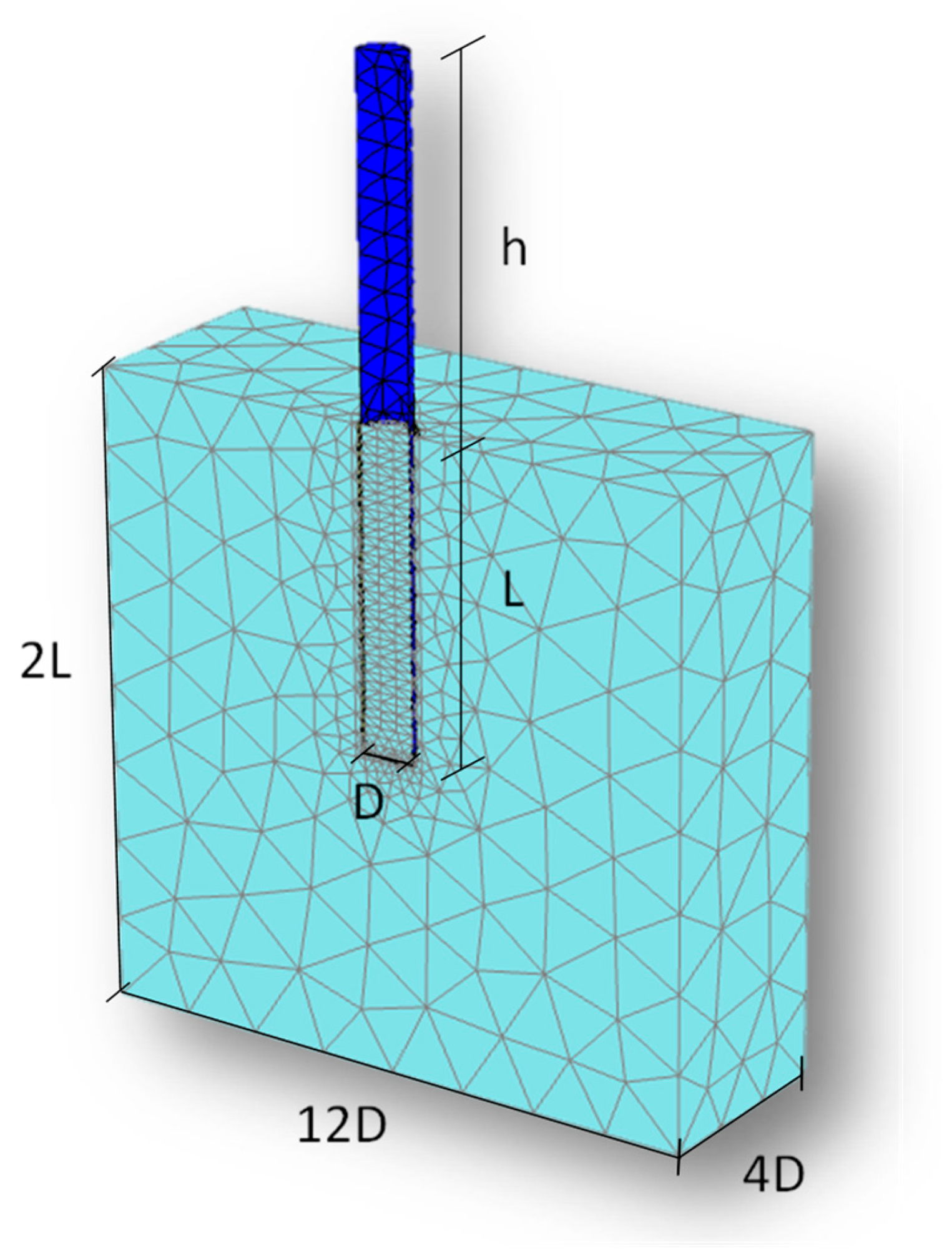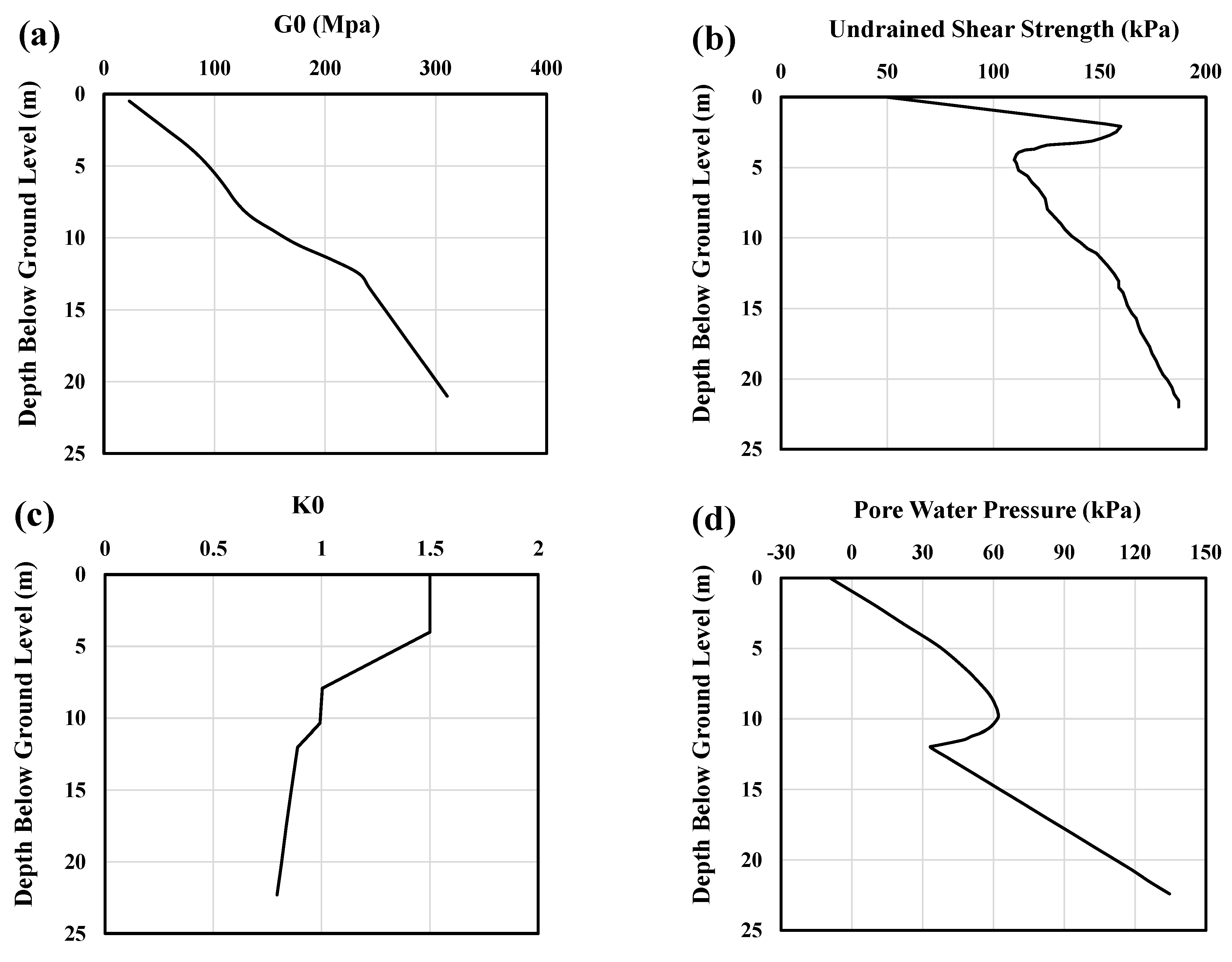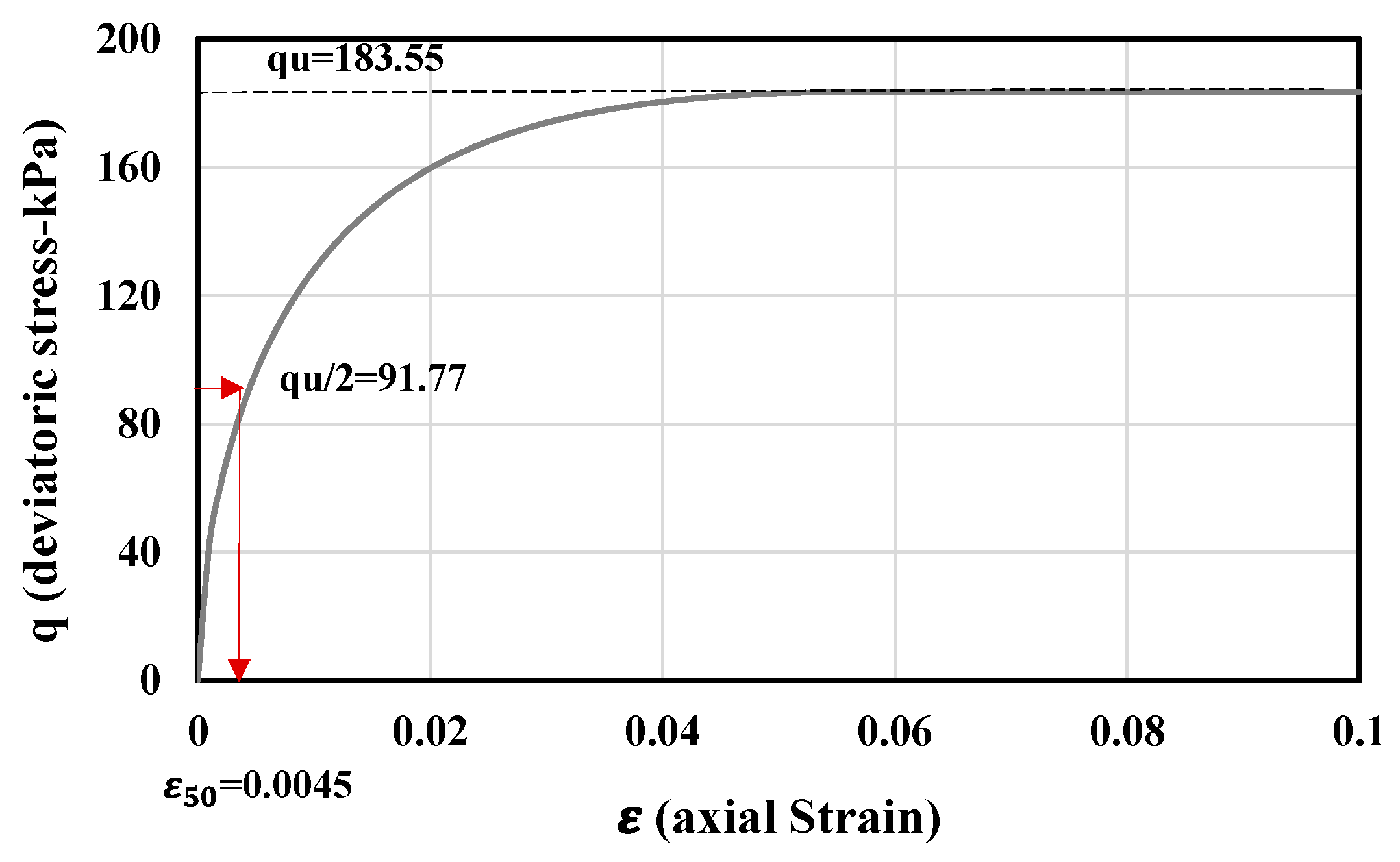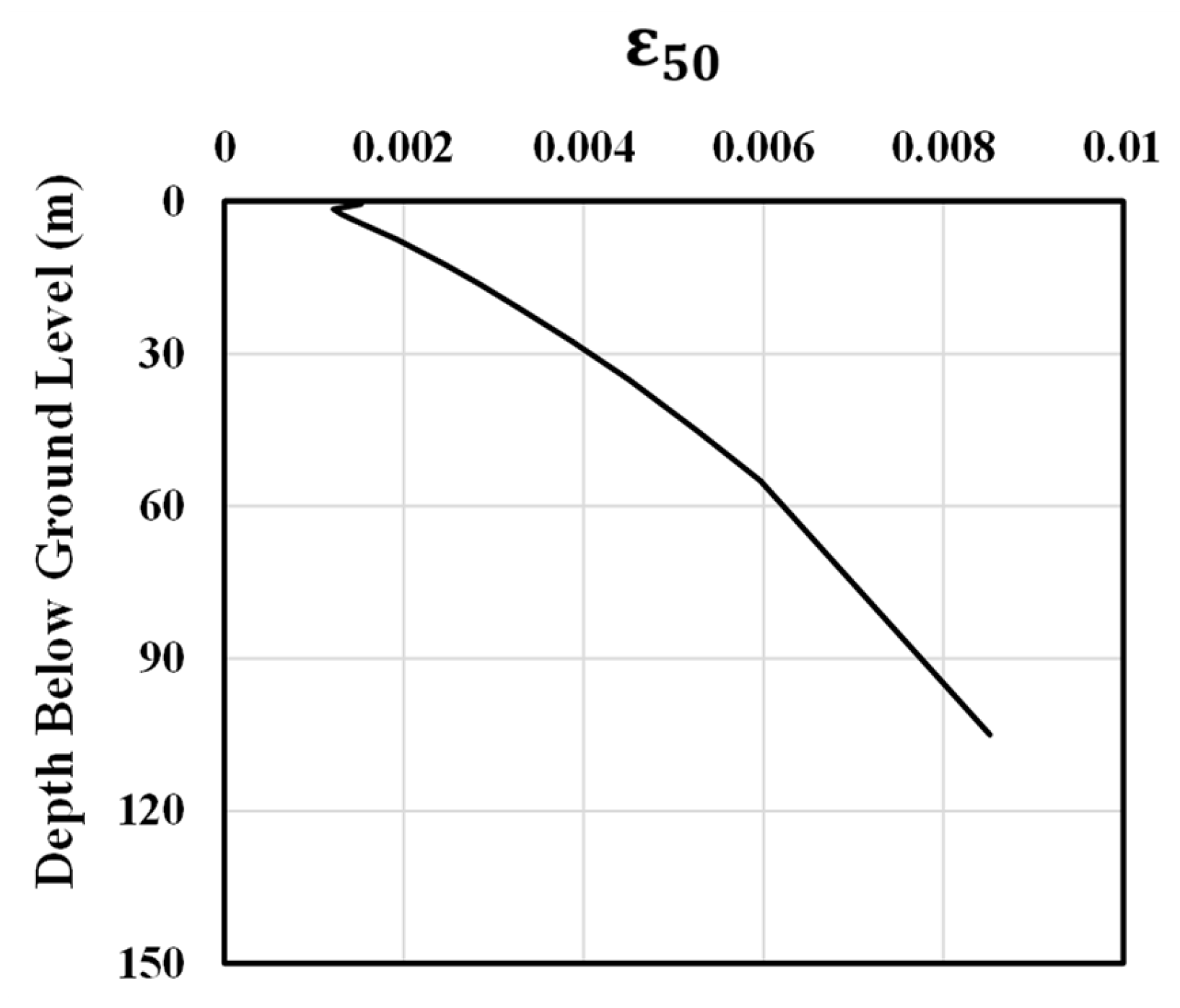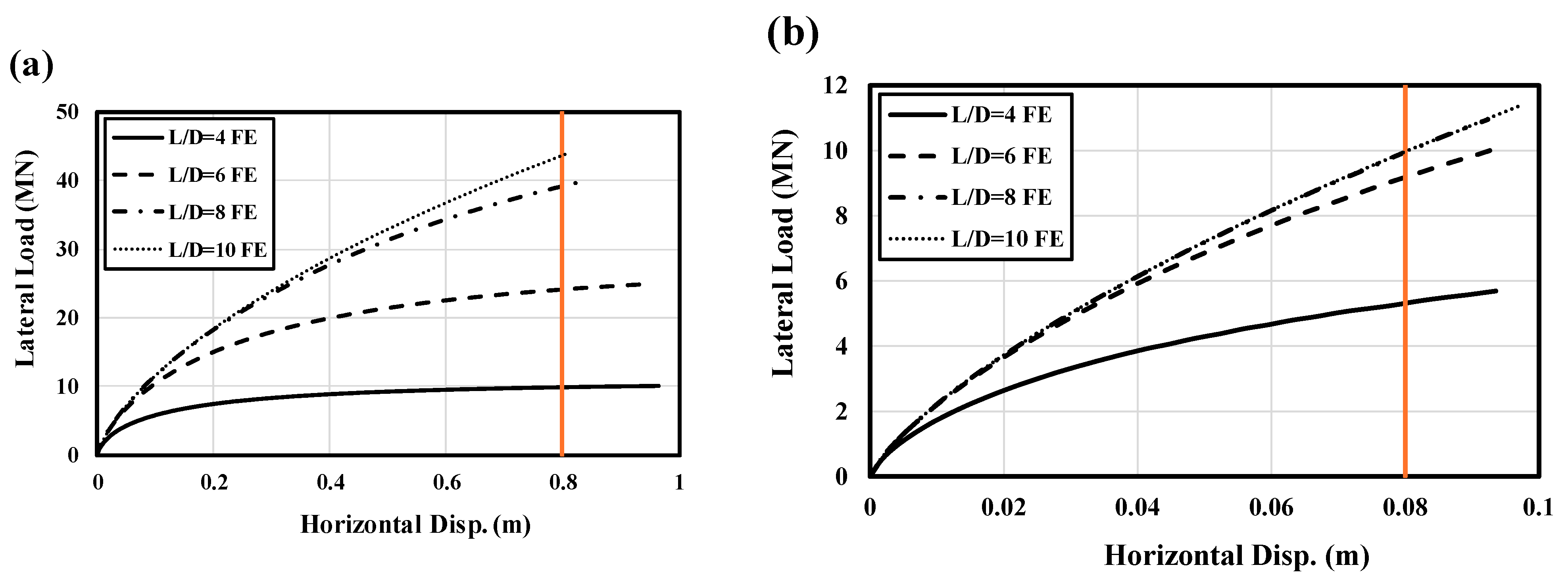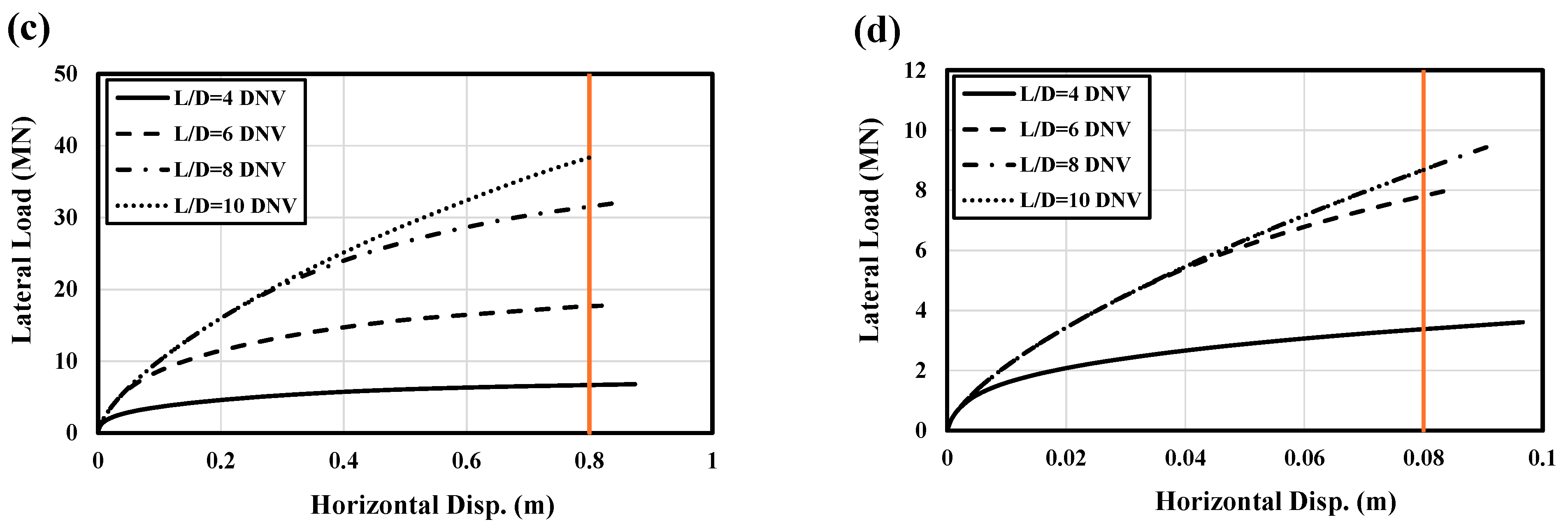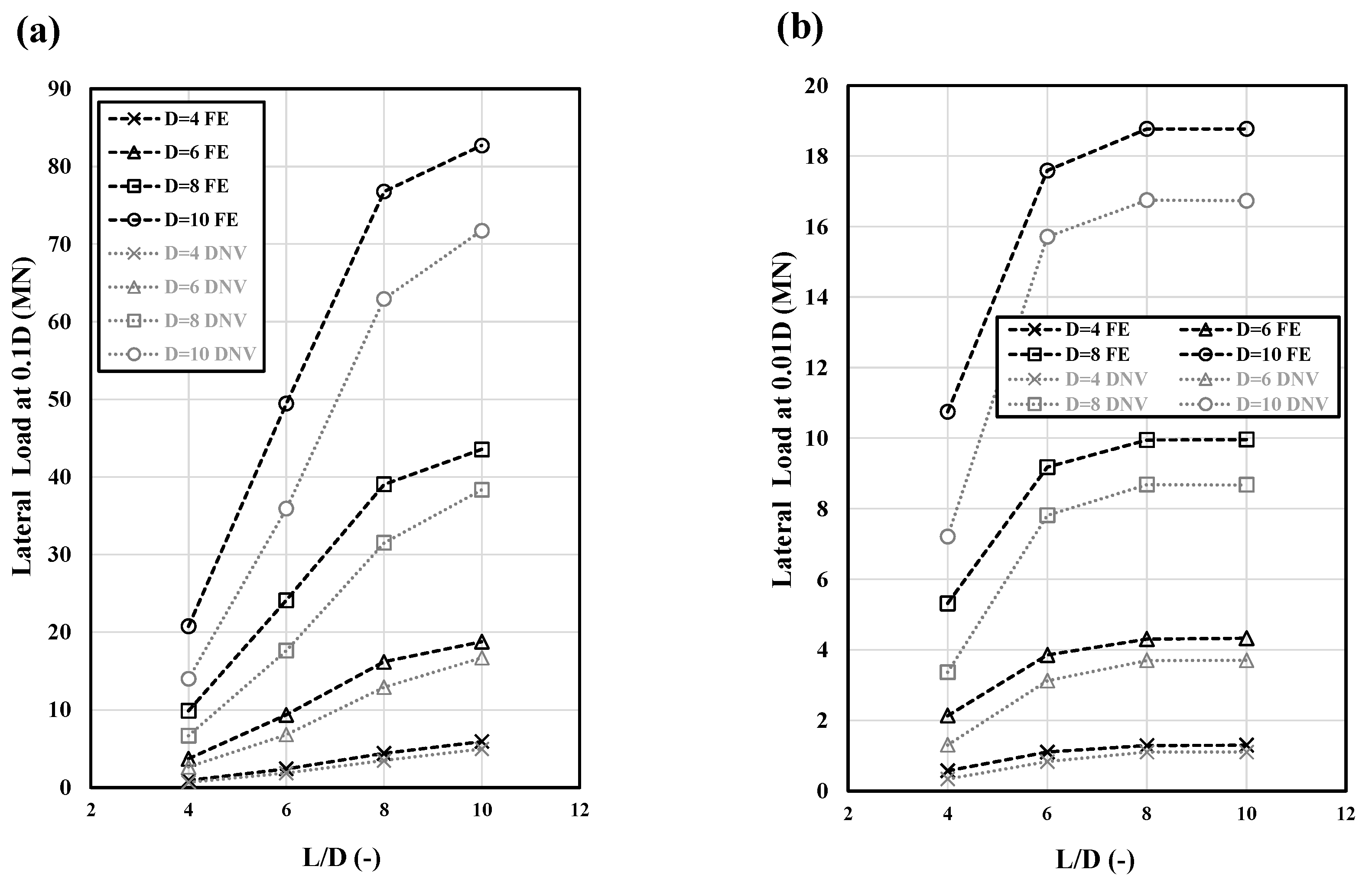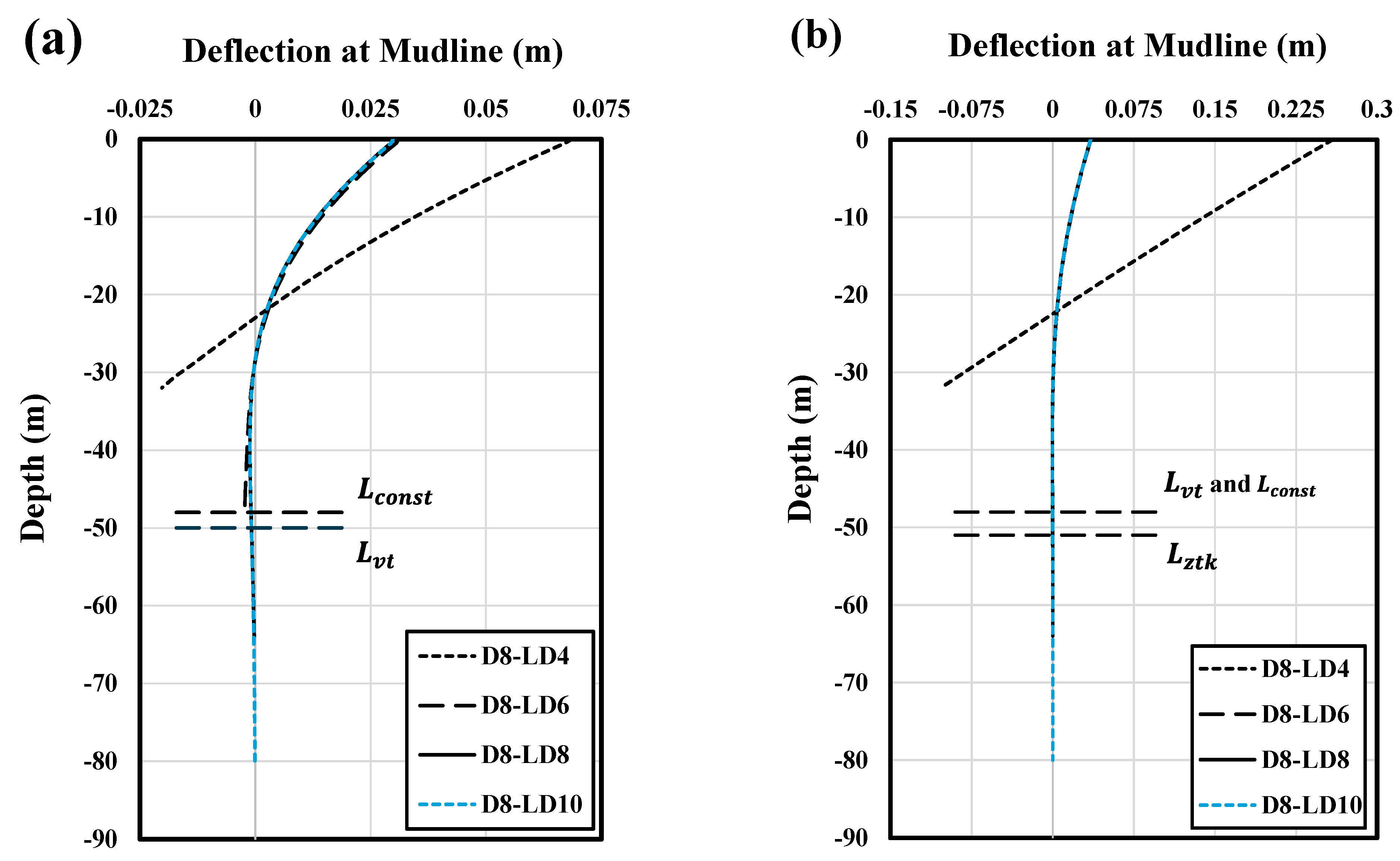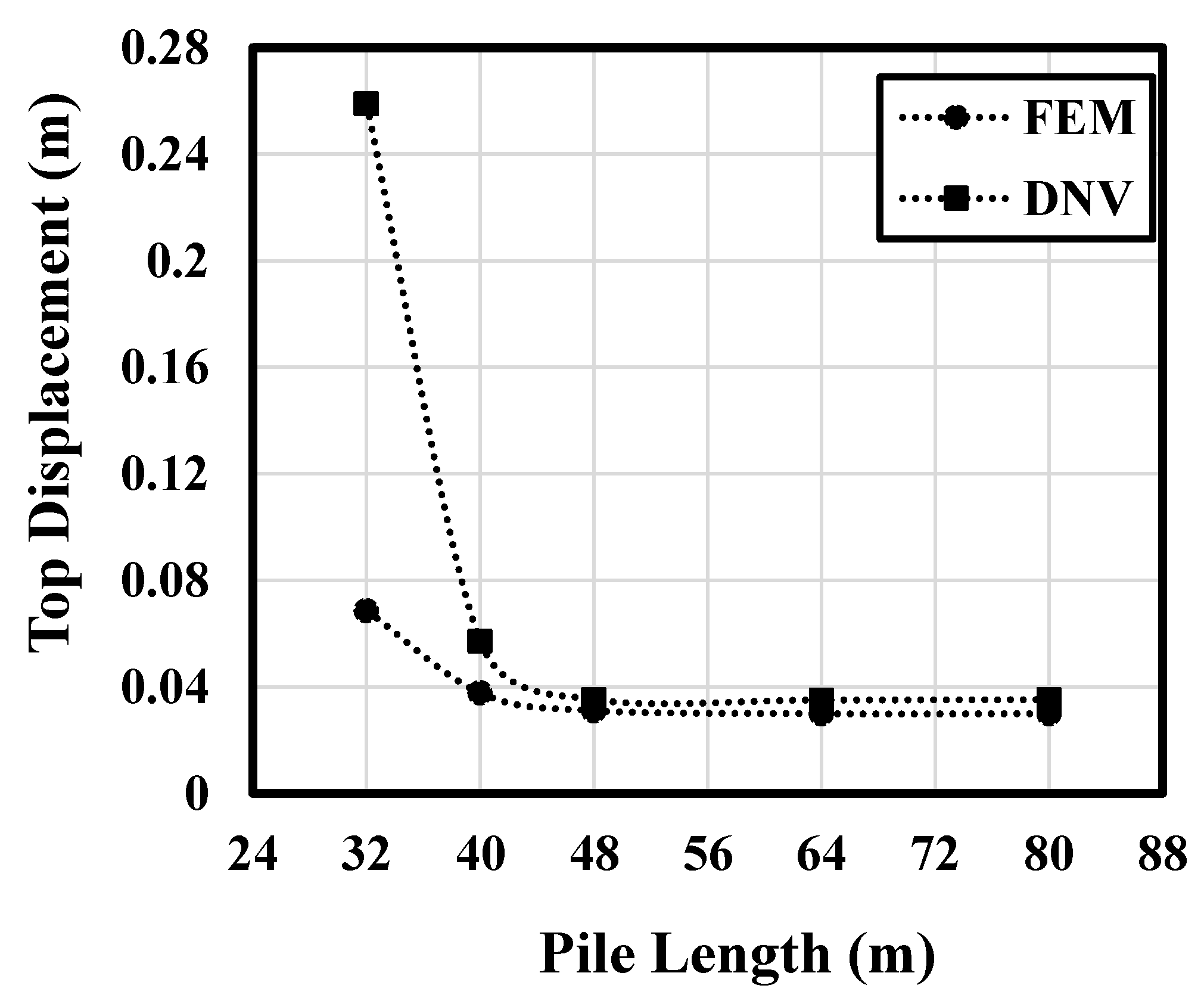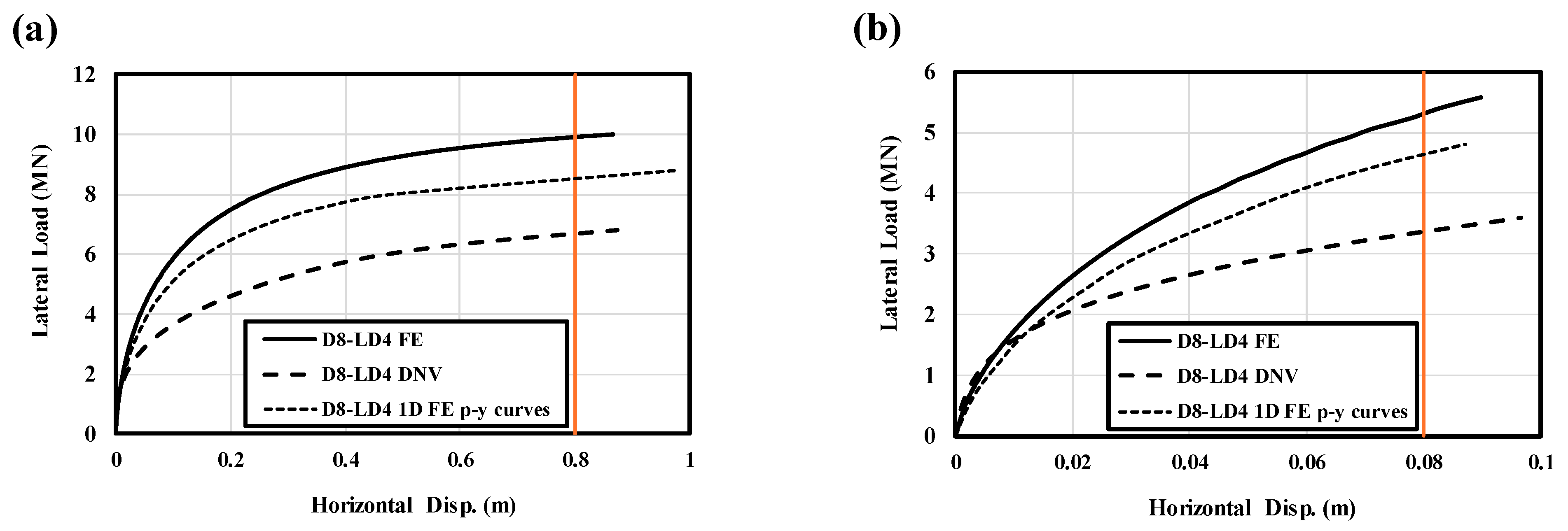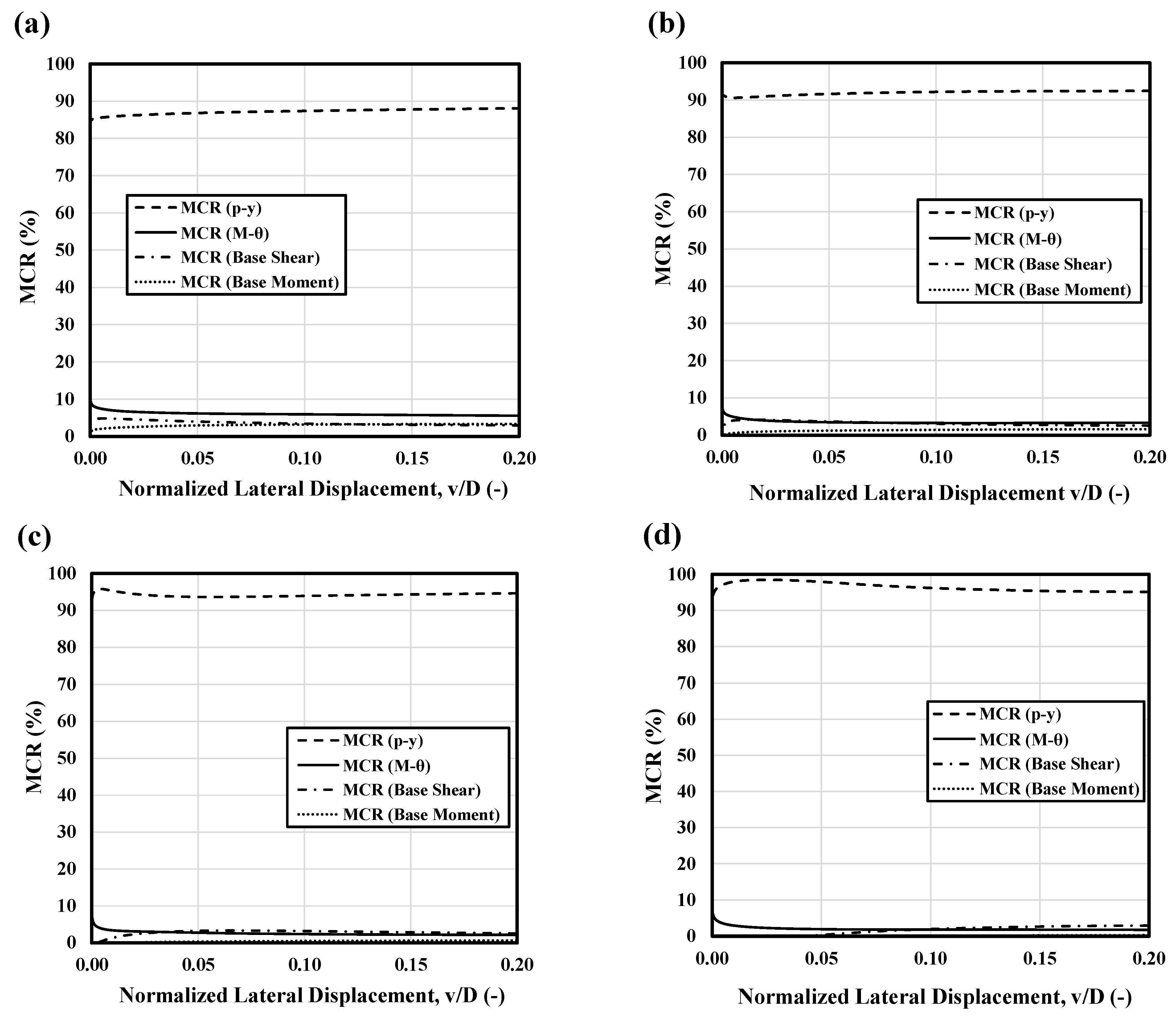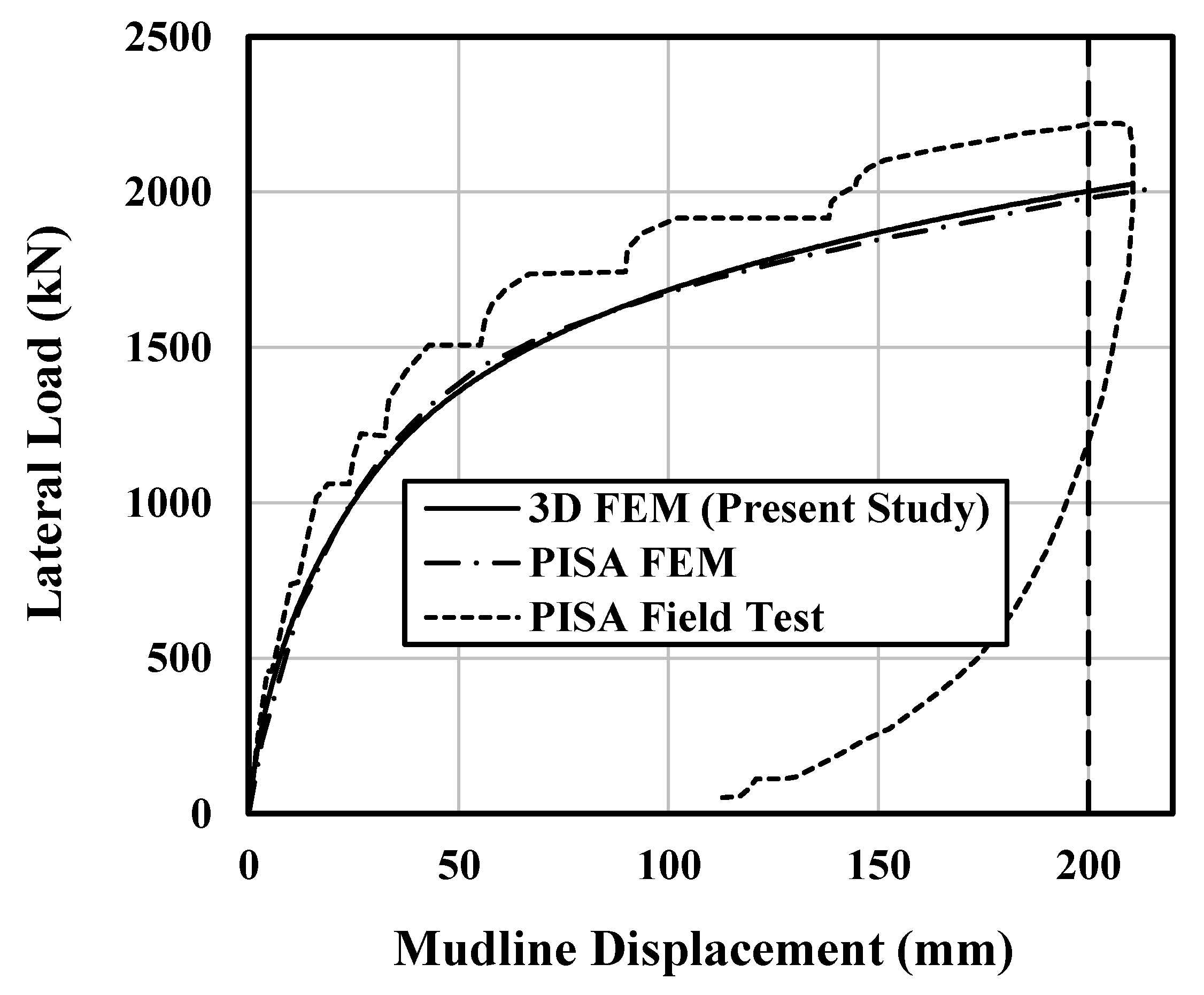1. Introduction
The development and utilization of renewable energy play a crucial role in achieving “carbon neutrality”. Among the renewable energy sources, offshore wind power has garnered significant attention due to its considerable potential in supporting the energy mix. Offshore wind turbines are supported by various fixed foundation systems such as gravity base foundations, tripod structures, suction caissons, jackets, and monopiles, among which, monopile foundations are currently the most appealing foundation system in moderate water depths of up to 35 m [
1]. This mainly stems from their fabrication and installation simplicity, cost-effectiveness, and established logistics [
2,
3]. Achieving a higher energy output from offshore wind is pursued globally at an ever-increasing pace, which is leading to the design of heavier turbines, taller support structures, and colossal foundation systems. Foundations may account for up to 40% of the total cost of an offshore wind project [
4].
Several initiatives were taken to lower the Levelized Cost of Energy (LCOE), which resulted in dropping the tender bid prices for offshore wind farms below the noteworthy threshold of 100 €/MWh from 2015 to 2016 [
5]. Such initiatives continue to make offshore wind energy a viable energy source, capable of competing against other forms of energy harvesting. Focus has been allocated to optimizing the design of the support structure, particularly the monopile foundation system, which constitutes a significant portion of the construction costs.
In this regard, current design procedures often adopt the standard p–y method—a simplified one-dimensional (1D) approach—in which the foundation is modeled as an embedded beam. Within this framework, non-linear p–y curves represent the lateral-load–displacement interaction between the soil and the embedded beam. Originally developed for slender piles of a high-embedded-length-(L)-to-diameter (D) ratio (L/D), the standard p–y approach, as proposed by recognized codes (e.g., API RP 2A-WSD and DNVGL-ST-0126 [
6,
7]), has been widely used in the offshore oil and gas industry [
8]. However, significant limitations exist when its application is extended to offshore monopile foundations with relatively small L/D ratios [
9,
10]. Such limitations stem from the discrepancies between the conditions for which the approach is developed and used.
The p–y approach was developed by studying slender piles with an L/D ratio of about 40 (diameter of 0.32 and embedded length of 12.8 m) for only a few cycles of lateral loading [
11]. On the other hand, monopile foundations for offshore wind farm applications are typically designed with significantly lower L/D ratios of around 6 or less and may experience millions of loading cycles in their lifetime [
4]. Monopiles experience bending and rotation when loaded laterally, with the balance between the two influenced by the embedment depth and rigidity. Typically, short, embedded piles (with a low L/D ratio) primarily rotate around a center of rotation with minimal bending, while longer, slender piles (with a high L/D ratio) exhibit more bending and a lesser degree of rotation [
12]. Due to these behavioral differences, the necessity of establishing tailored design methods for large-diameter, relatively short monopiles is felt to be an alternative to the standard p–y method [
13].
Therefore, different research and industrial institutes have allocated efforts to propose improved methods of predicting the lateral response of monopile foundations under different loading and soil conditions, adopting numerical, analytical, and experimental methods. In this regard, large-scale field tests were performed on monopiles in sand, clay, and chalk sites by PISA (Pile Soil Analysis) [
10], Li et al., 2017, at Blessington [
14], and ALPACA (Axial–Lateral Pile Analysis for Chalk Applying multi-scale field and laboratory testing) [
15]. Moreover, centrifuge testing, as a more convenient experimental method, has been performed by the authors in [
12,
16,
17,
18,
19,
20,
21,
22,
23].
Numerical and analytical studies have also contributed to the body of research on the lateral behavior of monopile foundations. In this regard, the pile–soil interaction has commonly been investigated using solid elements for numerical methods [
24,
25,
26,
27,
28] as well as discrete spring elements for both analytical and numerical methods [
8,
29,
30,
31].
The PISA project is one of the most comprehensive studies in this realm, intending to improve the conventional p–y method by incorporating supplementary soil resistance components that are significant for monopiles with a low L/D ratio [
32]. Termed as diameter effect, pile tip resistance and interface frictional resistance along the pile surface—as shown in
Figure 1—become considerable for large-diameter monopiles with a low L/D ratio [
10,
33,
34,
35]. Therefore, the PISA project accounted for the large diameter effect by considering four soil reaction components along the pile, namely, the lateral soil reaction along the shaft (p), the distributed moment reaction due to the vertical shear distribution along the pile (m), the shear force reaction at the pile base (
) and the moment reaction due to the normal stress distribution at the pile base (
) [
8].
The latest revisions of the DNVGL-ST-0126 guideline suggest that the p–y curves utilized in monopile design should undergo validation via finite element (FE) analysis. Nevertheless, there is currently no consensus on the best method to achieve this in practice [
26]. Although previous research has presented different methodologies to conduct such analysis for a wide range of monopile dimensions in homogenous and layered soils, their assumptions should be tested in different offshore site conditions. A literature review reveals that while studies on monopiles in sandy soils or rock-socketed foundations are abundant—reflecting the predominant site conditions in South Korea—few have focused on clay soil profiles in the region. Rigorously validated numerical studies based on large-scale monopile load tests in clay provide a valuable insight into monopile foundation performance, though such studies are limited in the literature. Therefore, more studies are required to develop a comprehensive understanding of the subject and to enrich the database needed to adapt the new design methods. Moreover, simplified one-dimensional methods, as proposed by API and DNV, are still used at the tender design stage and optimization of an entire wind farm, due to their analytical convenience when performing all the necessary design iterations.
In the present study, the lateral response of monopile foundations in clay has been investigated using 3D numerical modeling and the 1D standard p–y method proposed by common standards. The numerical model has been verified against the results of a large-diameter monopile test conducted by the PISA team at the Cowden site. The 1D standard p–y method, henceforth termed as the 1D DNV p–y method, has been conducted using a commercial finite difference software equipped with the p–y curve formulations suggested by Matlock (1970) and Reese and Welch (1975) for soft and stiff clay, respectively [
11,
36]. The difference between the predicted lateral response of the monopiles of various geometries using the above-mentioned methods has been evaluated for both small (service) and large (ultimate) displacements. Furthermore, the contribution of different resisting soil components on the lateral capacity of monopiles has been identified for various slenderness ratios, and some design aspects such as the minimum embedment length criteria have been investigated. Finally, several conclusions are drawn, providing factual insights into the shortcomings of the current practice in monopile design, merits offered by numerical modeling, and possible recommendations for improving the current standard p–y method.
3. Standard p–y Approach for Monotonic Loads
The behavior of laterally loaded piles is typically analyzed using the p–y method according to the DNVGL-ST-0126 and DNV-RP-C212 guidelines [
7,
43]. In this approach, the monopile is modeled as a beam with specific properties, connected along its embedded length to multiple springs, whose lateral-load–displacement behavior is defined by p–y curves. These p–y curves represent the ground response through a non-linear relationship between soil resistance and displacement at a given depth. For homogeneous soil conditions, both the ultimate strength (
) and initial stiffness (
) increase with depth [
1]. DNV-RP-C212 recommends different p–y curves for soft and stiff clay [
43]. For soft clay, defined as clay with an undrained shear strength up to 100 kPa, Matlock’s (1970) p–y curves are recommended [
11]. For stiff clay, defined as clay with an undrained shear strength exceeding 100 kPa, the procedures proposed by Reese et al. (1975) and Reese and Van Impe (2011) are recommended [
44,
45].
In this regard, Matlock’s (1970) soft-clay p–y curves were used for the upper depth (up to −30.6 m, where the soil’s undrained shear strength (
) is less than 100 kPa), while Reese and Welch’s (1975) p–y curves for stiff clay were employed at greater depths (beyond −30.6 m, where Su exceeds 100 kPa) [
11,
36]. Reese and Van Impe (2011) proposed two p–y curve formulations for stiff clay based on whether free water is present (Reese et al. 1975) or absent (Reese and Welch 1975) [
36,
44,
45]. The p–y curve with free water corresponds to the cases where annular scour occurs around the pile during cyclic loading (see
Figure 5). Considering that, in the present study, the monopile response under monotonic loading is of interest, the p–y curve without free water proposed by (Welch and Reese 1975) has been adopted for the layers.
The monopile foundation analysis was performed using the commercial software LPile v2022, which is tailored for evaluating laterally loaded piles via the p–y method. LPile utilizes a finite difference approach to solve the beam–column differential equation, enabling the determination of the deflection, bending moment, shear force, and soil response along the pile’s length. For both the Matlock soft clay and Reese and Welch stiff clay without free water, LPile requires three input parameters: undrained shear strength (
), effective unit weight (
), and the strain corresponding to half of the maximum difference in principal stresses in the stress–strain curve of the undisturbed specimen of clay (
). The profiles for effective unit weight and undrained shear strength are detailed in
Table 4. To ensure consistency between the two approaches, i.e., the FE and standard p–y methods,
values were directly derived from numerical simulations of undrained triaxial tests. PLAXIS software provides a single-element algorithm that allows the simulation of common geotechnical laboratory tests for a defined set of parameters in a given constitutive model. There is no need for meshing in this method, and only the initial stresses on a 3D single element are defined. Then, changes in stress or strain are applied to the element according to the desired test. In this study, a 3-axis compression test was simulated in a displacement-controlled manner to determine
. After applying the initial stresses on a hypothetical element at the desired depth (based on the vertical in-situ stress and the lateral soil pressure coefficient), the axial strain was increased in small steps until the failure of the element (q = qu). Then, the strain corresponding to half of the failure deviatoric stress was determined as
.
Figure 6 shows the simulated stress–strain curve for an element at the depth of −35 m. The
values used in this study are presented in
Figure 7.
4. Results and Discussions
This section examines and discusses the lateral load response of monopile foundations with varying pile geometries based on the results of FE analysis and the 1D DNV p–y method. In the FE model, the load is applied at a height of 40 m above the mudline, while in the 1D DNV p–y analysis, conducted using LPile software, the horizontal load is applied at the mudline, and the load eccentricity is considered by applying an equivalent moment to the monopile at the mudline.
A diameter-to-thickness ratio (
) of 100 is maintained across all models in this study. Since the focus is on the lateral behavior of the monopile, no vertical load is considered. DNVGL-ST-0126 states that a criterion on displacement shall be considered as the accepting criterion for adequate lateral pile resistance. Therefore, a displacement of 10% of the monopile diameter is used to define the ultimate lateral capacity and ultimate limit state (ULS) criteria in this study [
47]. Additionally, the serviceability limit state (SLS) criterion, based on the same code, is defined as an average rotation of 0.25 degrees at the mudline for a given load applied at an eccentricity above the mudline. The results of this study indicate that this rotation corresponds approximately to a lateral displacement of 1% of the pile diameter at the mudline, for all geometries studied, with a maximum divergence of 5% (see
Table 7). Consequently, for each monopile geometry analyzed, diagrams illustrating both large and small displacements will be presented and discussed.
Table 1 details the dimensions studied in this research.
The 8 m monopile serves as the reference diameter in this study.
Figure 8 illustrates the load–displacement curves for the D8-LD4 monopile, including results from both the numerical model and the 1D DNV p–y method. As can be seen, the DNV p–y method predicts a lower capacity of the monopile in both small and large displacements. Notably, the difference between the two methods increases with greater pile head displacement. In
Figure 8b, it can be observed that at very small displacements (less than 0.02 m), the curves overlap. However, as displacement increases, the difference between the two curves increases, eventually reaching a point where the amount of difference remains nearly constant.
Figure 9 presents the load–displacement results for all L/D ratios considered for the 8 m monopile in this study. Graphs (a) and (b) display the results from the FE model, while graphs (c) and (d) show the results from the 1D DNV p–y method.
Figure 9a,c indicate that monopile stiffness and capacity increase with the L/D ratio in both the FE and 1D DNV p–y methods. However, the rate of capacity increase diminishes as the L/D ratio rises. Specifically, the sharp increase observed from an L/D ratio of 4 to 6 turns into a more modest increase from an L/D ratio of 8 to 10.
This trend is more pronounced in small displacements (
Figure 9b), where increasing the L/D ratio from 6 to 10 does not significantly enhance capacity. The 1D DNV p–y results, shown in
Figure 9c,d, exhibit a similar trend and layout to the FEM results, particularly in the small displacements domain, albeit with a notably weaker load–displacement response.
Figure 10 shows the lateral load capacity of all monopile geometries studied in this research at displacements of 0.1D and 0.01D, based on the 1D DNV p–y and 3D FE methods. The results are categorized by small and large displacements for various L/D ratios (4, 6, 8, and 10 m) of the monopile foundations. The findings indicate that while there is a difference in capacity values between the FEM and DNV methods, both show a similar trend of increasing capacity with increasing pile embedment length. As is illustrated in
Figure 10a, for large displacements, increasing the embedment length for all monopile diameters leads to a continuous increase in capacity, with the rate of increase declining at an L/D ratio of 8 for both the 1D DNV p–y and 3D FE results. For small displacements, this decline in the rate of increase occurs at an L/D ratio of 6. Beyond this point, further increases in the L/D ratio do not result in significant capacity increases, causing the trend line to stabilize. This suggests that when considering small displacement or service criteria for determining the monopile embedment length, a smaller embedment depth can be selected compared to what would be required for achieving ultimate lateral capacity. Another notable point is the significant effect of increasing the monopile diameter on lateral capacity in both small and large displacements. While this approach can always be considered a viable solution, it is not always the most economical option.
The differences between the results of the 1D DNV p–y and FE methods, as shown in
Figure 10, are detailed in
Figure 11a,b for large and small displacements in percentages, respectively. According to these graphs, the maximum and minimum percentage differences between the 3D FE and 1D DNV p–y results are 41% and 11% for large displacements, and 32.5% and 13.3% for small displacements, respectively. The results indicate that as the L/D ratio increases, the percentage difference between the FE and 1D DNV p–y results decreases. While this reduction in difference has a steady trendline for small displacements, in large displacements, the rate of reduction decreases as the L/D ratio increases and stabilizes at an L/D ratio of 8 and higher. At an L/D ratio of 10, the discrepancy between the two methods narrows to an average of 13% across all monopile diameters, in large and small displacements. This reduction in the percentage difference with increasing L/D ratio is reasonable, as more slender monopiles align more closely with the conditions for which the DNV p–y method is designed. On the other hand, employing the 1D DNV p–y method for monopiles with an L/D ratio of less than 10 can lead to a substantial underestimation of their lateral capacity, potentially by as much as 41%. It is important to note that these quantities and ratios can vary depending on different soil conditions, the choice of constitutive models, and the specific loading conditions applied.
Figure 12a,b display the deflection profiles of the 8 m monopile at various L/D ratios, comparing the FE and 1D DNV p–y analyses, respectively. The deflection is obtained by exerting a 5 MN load at a height of 40 m above the mudline. As the L/D ratio increases from 4 to 10, the deflection at the pile toe decreases to nearly zero for both methods. At an L/D ratio of 4, the deflection profile is nearly linear with a constant slope, indicating rigid rotation with minimal flexure. The FEM results at L/D = 4 show slight flexure, while the DNV results indicate almost no flexure, suggesting nearly rigid behavior. As the L/D ratio increases to 10, the deflection at the pile toe approaches zero, being observed at L/D = 8 in the DNV p–y method and at L/D = 10 in the FEM results. Li et al., 2023, also reported zero deflection at depths of 7 to 9D in their experimental study [
12]. For intermediate L/D values, the deflection profiles exhibit a series of curved lines with nonzero values at the end of the pile, indicating a combination of rotation and flexure.
Determining a minimum embedded length to ensure the stability of offshore monopile foundations under severe loading conditions is a crucial step in their design. While various criteria exist for geotechnical monopile design, there is no widely accepted standard for determining the optimal pile length. In many projects, a rigid grip of the pile in the subsoil under significant static loads is essential, which necessitates either a deflection profile with two zero-deflection points (zero-toe-kick criterion,
) or at least a vertical tangent (vertical-tangent criterion,
) [
48,
49].
The aforementioned criteria may lead to excessively long embedded pile lengths for large-diameter monopile foundations with significant bending stiffness [
50]. As an alternative, DNVGL-2016 proposes analyzing the influence of increased embedded length on pile head displacement and selecting an embedment length that places the design on the “flat part of the corresponding displacement–length curve”. This means that the length (
) should be chosen such that further increases in monopile length have minimal impact on pile head deflection.
Based on the descriptions provided, the critical lengths according to different criteria can be analyzed for both the 1D DNV p–y and FE methods using the data in
Figure 12 and
Figure 13. According to
Figure 13, the
for both methods is achieved at a pile length of approximately 48 m, beyond which further increases in pile length do not significantly reduce monopile head deflection.
The results also show that the vertical-tangent criterion leads to almost-similar pile lengths, with approximately 48 m for the 1D DNV p–y method and 50 m for the FEM results. Although the vertical-tangent criterion offers embedded lengths similar to the DNV recommendation, previous research has highlighted its unreliability, as this criterion may result in shorter embedded lengths for higher load eccentricities. This is not desirable, as a suitable criterion should lead to a larger pile length for more critical loading conditions [
50]. The zero-toe-kick criterion, on the other hand, leads to the longest pile lengths, with approximately 51 m for the 1D DNV p–y method and more than 80 m for the FE results, under the 5 MN load considered.
The response of the monopile using p–y curves extracted from the FE model was also investigated using LPile software. This analysis was conducted for different L/D ratios of the 8 m monopile, the reference diameter in this study. The p–y curves can be extracted from the numerical model, y values through the direct output of the model, and p values from the numerical integration of normal and shear stresses on interface elements. The p–y curves were inserted into the LPile model using the user-defined p–y-curve option. Henceforth, these results will be referred to as the 1D model with FE-extracted p–y curves.
Figure 14 compares the results of the FE analysis, 1D DNV p–y method, and 1D model with FE-extracted p–y curves. It can be seen from
Figure 14a,b that in low slenderness ratios (i.e., L/D = 4), there is a clear difference between the results of the FE model and the 1D model with FE-extracted p–y curves for both small and large displacements, highlighting the influence of additional components contributing to the lateral capacity of the monopile. However, as the L/D ratio increases to 6, 8, and 10, the 1D model with FE-extracted p–y curves converges more closely to the FE results. This indicates a reduction in the contribution of other resisting components. At an L/D ratio of 10, the results from the 1D DNV p–y, FE, and 1D model with FE-extracted p–y curves are quite similar, indicating minimal diameter effects for slender monopiles. This demonstrates that for slender piles with an L/D ratio of 10 or higher, the 1D DNV method can predict pile behavior with reasonable accuracy.
To evaluate the impact of the pile slenderness ratio (L/D) on the relative contribution of the four resisting components, the contribution of each component was expressed as a percentage of the applied moment around the center of rotation (which equals the restoring moment exerted by the soil on the pile). The total moment contribution from the p–y and base shear components (i.e., force components) was determined by multiplying the component force at each depth interval by its distance from the center of rotation (the point of zero lateral displacements, calculated during each load step) and summing these moments for each component. The contribution from the distributed moment caused by vertical shaft shear forces was calculated by integrating the distributed moment, m, along the length of the pile shaft. The total moment from each soil reaction component was then divided by the externally applied moment (applied lateral force × vertical distance to the point of rotation) to calculate the “moment contribution ratio” (MCR). The maximum displacement of 0.2D has been exerted on the monopile, and the displacement of the graphs presented in
Figure 15 has been normalized by the diameter of the monopile (D).
The MCR values for each soil reaction component at slenderness ratios of 4, 6, 8, and 10 are presented in
Figure 15 for the 8 m monopile. The results indicate that the primary portion of the resisting moment across all slenderness ratios is provided by the distributed lateral load acting along the monopile shaft (
). Furthermore, the contribution of this component increases as the slenderness ratio increases. Specifically, the contribution rises from approximately 87% at an L/D ratio of 4 (
Figure 15a) to about 96% at an L/D ratio of 10 (
Figure 15d). Conversely, the combined contribution of other components—shear force at the pile base (
), vertical shear stresses acting on the pile shaft (
), and base moment (
)—decreases as the slenderness ratio increases. At an L/D ratio of 4, these components contribute around 13% (
Figure 15a), but their combined contribution drops to 4% at an L/D ratio of 10 (
Figure 15d).
The results also revealed that the base moment minimally contributed to the moment resistance of the monopile with a contribution of around 3 percent at an L/D ratio of 4 and almost zero at an L/D ratio of 10. Except for the L/D ratio of 4 where the vertical shear stresses along the pile shaft, have a relatively greater contribution, in other L/D ratios, the and have similar contributions.

